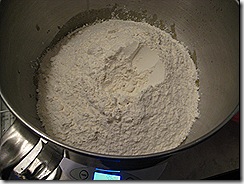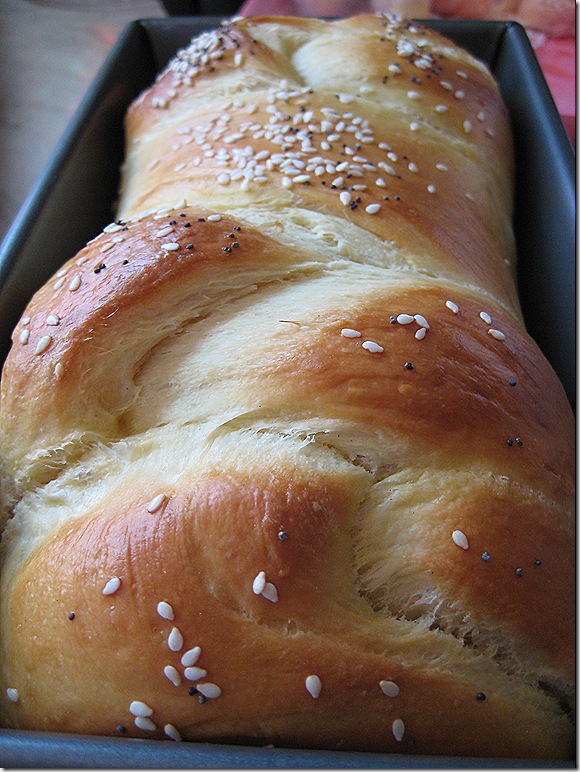So the other week I decided to try my hand at making some challah. I had a recipe saved that I wanted to try from Peter Reinhart (which I got from Michael Ruhlman’s website), who is a famous bread man, which is actually the scientific term for a man of the bread. Look it up.
Here’s the thing about challah. Challah, much like it’s Russian cousin brioche, is traditionally made with a lot of added fat, and some sugar which gives it it’s classical color and consistency. The added fat in challah is traditionally egg yolks (whereas in brioche it’s butter…), and you know me, I must adhere to tradition. So yeah, there are a lot of egg yolks. The recipe calls for 170 grams of egg yolks. That’s about 26 eggs…ok not really, it’s about 8-10 egg yolks (but its much less than 26 right?). I know what you’re thinking “How are you not on the biggest Loser?” That’s a good question, but here’s my justification, if you’re going to make something make it how it’s supposed to be made, at least the first time you make it, and then you can tweak it the next time. Makes sense right? Also, this batch made 4 large challahs, one medium one, and 3 rolls, so not an epic fat-fest in the long run.
Anyway – challah has sugar and fat in it, which actually prevent the gluten from forming properly, however this lack of properly formed gluten is what gives it it’s tenderness, but therefore it needs to rise for a longer period of time. To accommodate that, we’re going to make the dough in advance, and let it rise in the fridge which retards (yes that’s the actual word) the rise, and lets it rise for an extended period of time (you can make this up to 4 days in advance). This also lets the dough develop more flavor, so it’s a win win!
Baking is more of a science then cooking, and whenever possible I like weighing out stuff, instead of measuring it. Not only is it more accurate, there’s also less stuff to clean after, so that’s always a plus.
Start by measuring out your yeast and water, and mix to combine
Then add the egg yolks, oil, sugar, and vanilla to the water/yeast mixture, and mix that up.
Then add your flour and salt, and with the paddle attachment, mix until it just comes together, about 2 minutes on the lowest speed, and then let the dough rest for 5 minutes.
After 5 minutes, put the dough hook on ad knead for about 4 minutes on medium-ish. When that’s done, plop the dough down on a floured surface and knead a little more until the dough is soft adding a little flour as needed. You’ll know when it’s done. Then transfer it to an oiled container for it’s retarded retardation in the fridge, and go get some well needed rest, you deserved it…I’ll see you in a few days. 

Ok – you’re back, rested up, and ready to bake. I like your enthusiasm. But wait – we’re not ready to work just yet. Take the risen dough out of the fridge and let it rest at room temperature for at least 2 hours before we start manhandling it. It will make it much easier to work with.
After 2 hours, transfer the dough to a floured surface, and divide the dough into however many portions you need (whether you’re gonna braid it or not).
Shape your loaves and set on a baking sheet or loaf pan.
Combine the egg white, and water to make the egg wash, brush the loaves with the egg wash, and let it sit for an hour (reserving the egg wash in the fridge). Then, re-apply your coating of egg wash, sprinkle with poppy and sesame if using, and let it sit for another hour.
15 minutes before the dough is ready, preheat the oven to 350. When the dough has risen, bake for 20 minutes, rotate the pans, and then bake another 15-30 minutes. Let cool for 45 –60 minutes, and then rip it apart like the ravishing person you are.
I’m not gonna lie, the challah was pretty awesome. Not necessarily the best tasting challah I’ve ever had (that’s not to say it didn’t taste good, it did, but it wasn’t the best), but in regards to texture, it was dead on. I’ve never had homemade challah that was this perfect in texture. It was soft, tender, and had a great crust and crumb. Also because of the added fats, it keeps really well.
By the way, as per the website I got the recipe from, if you want to use whole eggs, and not just egg yolks, you can, just omit 2 tablespoons of water per whole egg you use. 
Challah
Ingredients:
- 2 ½ cups/510 grams lukewarm water
- 1 ½ tablespoons/14 grams yeast
- 8–10 egg yolks or 170 grams depending on weight of yolks
- 5 tablespoons/71 grams vegetable oil
- 6 tablespoons/85 grams sugar, or 4 ½ tablespoons/96 grams honey or agave nectar
- 1 tablespoon/21 grams vanilla extract (optional)
- 7 ½ cups/964 grams unbleached bread flour
- 2 ½ teaspoons/19 grams salt or 4 teaspoons/20 grams coarse kosher salt
- 1 egg white for egg wash
- 2 tablespoons/30 grams water for egg wash
- 2 tablespoons/20 grams sesame or poppyseeds for garnish
Directions:
To make the dough:
- Combine the water and the yeast in a mixing bowl or the bowl of a 5-quart mixer and whisk together to dissolve. Add the egg yolks, oil, sugar, and vanilla, if using, and whisk together to break up then add the flour and salt.
- Using the paddle attachment, mix the dough for 2 minutes on the lowest speed. Let the dough rest for 5 minutes.
- Switch to the dough hook and mix on medium low for 4 minutes.
- Use a floured bowl scraper or floured hands to transfer the dough to a lightly floured surface, sprinkle the top lightly with flour and knead by hand for a couple of minutes until the dough is soft and supple. It should be tacky but not sticky.
- Place the dough in a lightly oiled bowl, or divide the dough in half or in as many portions as you plan to bake, and place in oiled bowls. Cover and immediately place in the refrigerator. The dough should rest at least overnight and can be kept refrigerated for up to 4 days.
To make the Challah:
- Remove the dough from the fridge approximately 2 hours before you plan to bake. Transfer it to a lightly floured surface and cut it into the desired number of braids you want to use or shape into loaves, or dinner rolls.
- Shape as desired and place the loaves on sheet pans lined with parchment paper.
- Make the egg wash and brush each loaf with the wash. Reserve the rest of the wash in the fridge, and let the loaves rise uncovered for about an hour. They will not have risen much at this point. Brush the loaves again with the egg wash and sprinkle with poppy seeds or sesame seeds or a combination of both.
- Let the loaves rise for another hour until they increase to about 1 ½ times their size.
- 15 minutes before baking, pre-heat the oven to 350 degrees F./177 degrees C. or 300 degrees F./149 degrees C. for convection.
- Bake for 20 minutes, then rotate the pan and bake for another 15 to 30 minutes, until the loaves sound hollow when thumped on the bottom.
- Cool on a wire rack for at least 45 minutes before slicing and serving.








WOW
looks great
can’t wait to taste it, if there are leftovers
LikeLike
Sorry bro, leftovers are a rarity down here 🙂
LikeLike
ooh you beat me to it, i’ve been meaning to try this recipe ever since mr. ruhlman posted it on his blog! it’s going to happen right after pesach!
LikeLike
Yeah I’ve had it saved for a while…nows the perfect time when ur trying to get rid of all ur chametz!
Do it
Do it
LikeLike
Nice post. When I first read the recipe on Michael Ruhlman’s site, my first thought was – should I trust a challah recipe from someone thats a bread man or from my grandmother who’s learned how to make challah from her mother :).
LikeLike
Yeah I know what u mean…but I figured I’ll try something new and different and why not from someone who knows what he’s talking about
LikeLike
was ur wife insulted that you said it was one of the best homemade challaha’s u ever had
LikeLike
Ha shhhhh, don’t tell her…and texture wise, I think she’ll agree…maybe?
LikeLike
Vanilla? In Challah? Sounds goyish. Did you eat it with honey-walnut cream cheese, or maybe miracle whip?
LikeLike
ha, hows it any different than cinnamon and sugar? and happens to be i hate sweet cream cheese, ugh
LikeLike
Cinnamon & sugar = babka. Vanilla = little goyishe elves.
Sweet cream cheese is the height of goyish maichel. On the other hand, so is BBQ, so my comment is not meant to denigrate, as much as to discriminate. 🙂
LikeLike
First of all babka?? Vus mein?? U mean kokosh, and that’s with chocolate…plus doesn’t ur wife make challah with cinnamon and sugar????
LikeLike
Challah with C & S has a Yiddish yichus (i.e. babka). Kokosh is a Hungarian rooster, no?
On that note, maybe séf gasztronómia would like to expound on the difference between kokosh and babka. I never quite figured that out. I was too busy paying attention to the sugar content of a good dry rub.
LikeLike
yes, but challah isn’t bobka, and to answer your question – bobka is what “haye-mishers” (not haymishers) call kokosh, make sense?
LikeLike
Dvora also makes Haber Challa, which has many mystical properties:
1. The recipe “just appeared”, a la a Breslov tale of Na Nach Nachman.
2. It changes properties from baker to baker.
3. It has no eggs, making it magically “healthier”
LikeLike
it’s also not kneaded, meaning it’s more a cake than a bread, but i digress
LikeLike
Nem teljesen igaz!
Depending on the Haber, it is lightly kneaded by hand, or kneaded in a mixer, changing the gluten properties from house to house. This would explain the differences mentioned above. Now, if you mean multiple rises and beatings in the Ungarish Magic Mill, you are correct.
Perhaps for a further post you might do a “food lab” article and decipher the recipe?
LikeLike
I think the first food lab would have to b on my potato kugel, which is different kitchen to kitchen
LikeLike
My guess might be the type of potato. Sounds interesting! I’ll be happy to be in the tasting part of the lab (not the grating!!!!!).
LikeLike
Birshuuuuuuuuuuus.. nosssssi. I would love to cut that open, mix some chrayn and mayonaise together in a bowl and dip that challah in it.. Then take some more challah and open up the sabras chumus and dip it in and pick up some chick peas in oil on the way out. Then I would finish off with a drop of babaganush, a heap of matbucha, with some roasted eggplant, and turkish salad….
LikeLike
Mmmmmmm chrayonaise-chummus-babaganoush mix…my favorite
LikeLike
Im surprised youre letting anyone dip your precious challa (do they call it challee in Baltimoran?) in anything other than olive oil with fresh pepper…gastronomical
I would stick some creme fraiche on it and be done!
LikeLike
Oh Shuy, Of course they call it challee (good call)…I let them dip it in some “fresh peppi”…they can dip it in creme freeeeeesh, but they have to sing the song (la la la la la la creme freeeeeeeeesh)
LikeLike